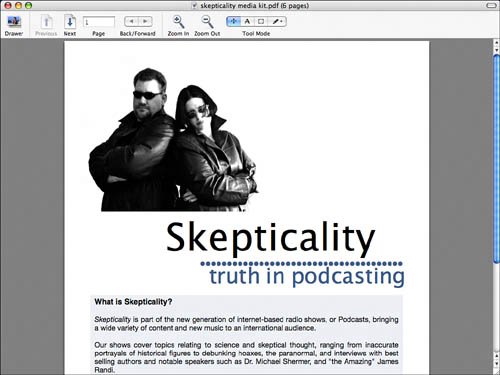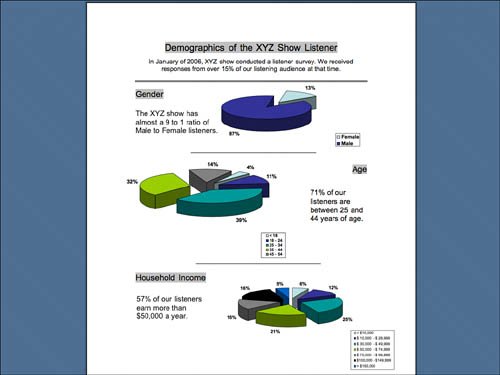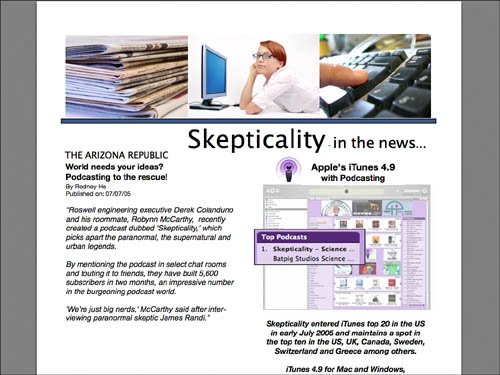Creating a Media Kit
| Once you have gathered together all the information about how many people are listening to your show and who those people are, you are then ready to start putting together a media kit. When a potential advertiser is looking for a show to advertise on, he is usually going to have to justify spending that money to someone above him. The information you give him in your media kit is often used to make his case about why he decided to advertise on your show. Some advertising networks offer a generic media kit; however, you should still put together a detailed kit yourself. Something to remember about the advertising networks is that the best publicly known advertising deal in podcasting was not brokered by an ad network, it was brokered between a podcaster and an advertiser with no middleman. Having a good media kit gives you the opportunity to at least see if you can broker your own deal. Even if you already decided to use a network because you do not have the time to look for advertisers, having your own detailed media kit makes your podcast stand out in the eyes of potential advertisers when comparing you to others in your network. We realize that not everyone has created a media kit before, so we are going to take you through the different items you need to address in a media kit and show you, step by step, how to create one. Here is the basic outline of what should be in your media kit:
The following sections break down in detail each section of the media kit. The page numbers are for reference only; based on your specific information you may be a couple pages shorter or longer. Page 1: The Cover PageWe are back to the issue of first impressionsbut this time it is not about listening, it is about viewing. You need to make the cover page look professional and visually appealing. In the top half of the page, place a picture/image of your show logo and name (see Figure 18.3). The bottom half of the page covers what your podcast is about and when you release shows. Figure 18.3. The cover page for the Skepticality media kit demands your attention. Here's an example of a cover page that addresses these questions:
The formatting and spacing of the text on the cover page should be consistent with the format of the text on your website. This will help reinforce the brand image of your show. We are not saying to use a funky sideways stencil font; the text still needs to be readable. If you do not have a font on your site that easily transitions to print, then choose a standard font such as Times New Roman font size 12, with 1.5 line spacing. Now after you have introduced the potential advertisers to your podcast, many are going to wonder what a podcast is and why they should care. Page 2: What Podcasting IsThe second page of your media kit is where you should explain what podcasting is in a manner that someone who is not very technical can understand and why it is they would want to advertise on a podcast. The following is our example. Feel free to use all or part of this explanation in your media kit.
It is important that you let people know that you do not need an iPod to listen to a podcast and that any computer can be used to listen to a podcast. This lets those who are not very technical understand that the potential audience for your podcast is very large. Page 3: Who Is Listening to Your ShowNow that you've introduced your podcast and educated your potential advertiser on the nature of podcasting, it's time to go over the demographics of the listeners. There are four key metrics any advertiser wants to know:
If you really want to show that you've done your homework, you could also include the following information:
You may also want to include topic-specific data geared to your type of show. If you have a show on parenting, maybe you want to break down the number of kids your listeners have. Figure 18.4 shows an example of what the demographics page could look like. If you gather enough information on your listeners, this section could be three or four pages long. Figure 18.4. Age, gender, and household income demographics for listeners of the XYZ Show. Page 4: Who You Are and Who Likes YouAdvertisers do in fact care a great deal about the type of person they associate with their products and services. It's not purely about the size of your audience. So this page of your media kit needs to give them some background information on yourself and, if you have any, your co-hosts. Some fun facts are always good here. You want to try and connect with your potential advertisers. They need to understand what type of person is going to be hawking their wares. This page is also a good place to list where your podcast has been mentioned in the press or on other podcasts. It's always better to have other respected individuals and publications espouse the virtues of your podcasts so that it's not just you saying, "Hey, I'm great. Take my word for it." If you have some good quotes from the press or other podcasts about your show, you should share them here. (See Figure 18.5.) Figure 18.5. Skepticality in the news. This shows some great examples of using news quotes in your media kit. Page 5: Why People Are ListeningThis might sound like a hard question to answer, but chances are you already have the answers in the form of feedback from your listeners. This is a good place to have quotes from your listeners. Let them state in their own words what they think of your show and why they listen. If you can convey to your potential advertisers that you have a loyal fan base, they will feel much better about advertising with you. If you have the data and it is positive, this is a good place to add in trend lines for your subscriber stats and/or total download stats (see Figure 18.6). Figure 18.6. Quotes from listeners and subscriber stats for podCast411. Page 6: Sponsorship and Advertising OpportunitiesPotential sections for this page include the following:
Remember, the media kit is for potential advertisers, not for your audience. Don't use slang from your show in the kit without defining that slang. Be professional and do not assume the advertisers understand podcasting. Where to Send the Media KitNow that you have gone through all the trouble and work of putting together the media kit, you probably want to know what to do with it next. First, you can link to it from the website for your podcast, or at a minimum you can let potential advertisers know it exists and ask them to send you an email to request a copy of the media kit. The latter is suggested if you are giving out information in the media kit such as your real name or home address. We have heard many podcasters say, "Because my show is X-rated, no one will want to advertise on it." This is absolutely not true. Go and pick up a copy of the latest Playboy or Penthouse magazine. Both are filled with advertisers that would be a good fit for an X-rated or even R-rated podcast. If you have a podcast about paintball, then get a couple magazines on paintball and see what companies are advertising. Google those companies, find a contact, and then email or snail mail your media kit. Also, go to blogs and websites that talk about a subject related to your podcast. Look and see who is advertising in the banner ads for those sites. Finally, if other podcasts out there are similar to yours, listen to find out who is advertising on them. These advertisers will likely be interested in advertising on your show. In some cases, advertisers will approach you, but for the most part you will need to be the one knocking on doors and selling your show. Your media kit is one of the most important tools you will have when you are trying to get advertisers to hand over their cash. |
EAN: 2147483647
Pages: 162